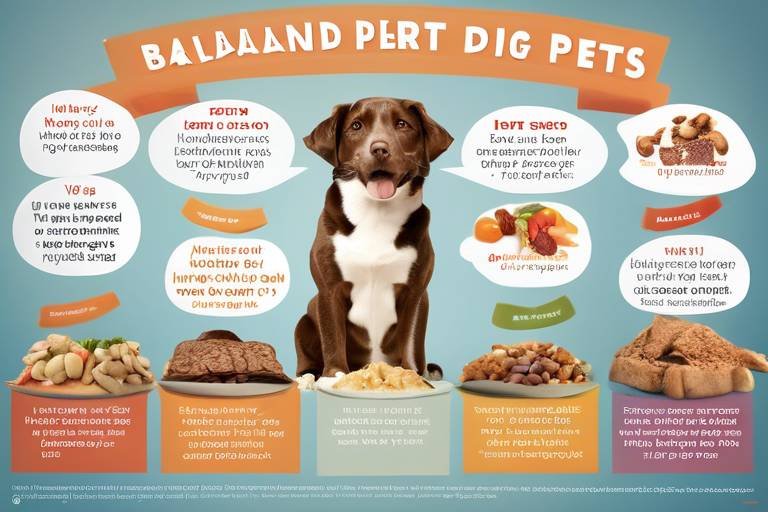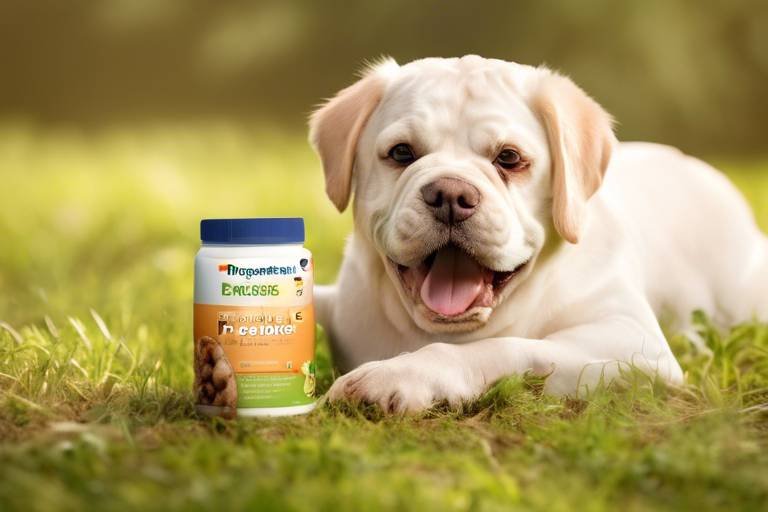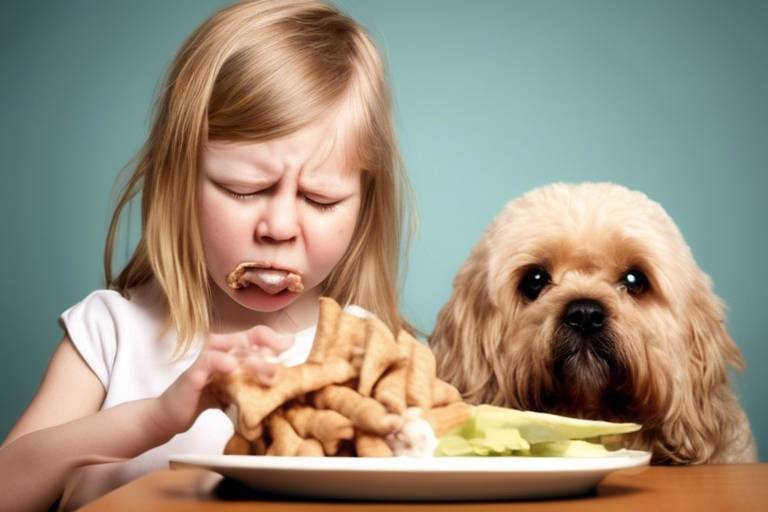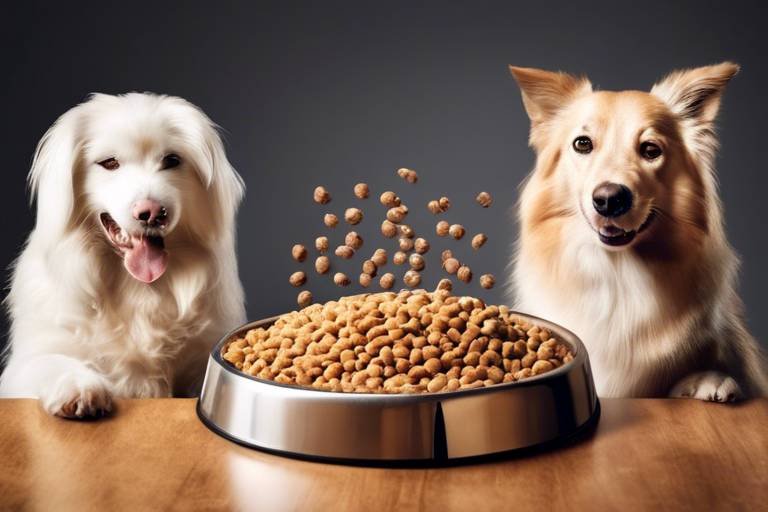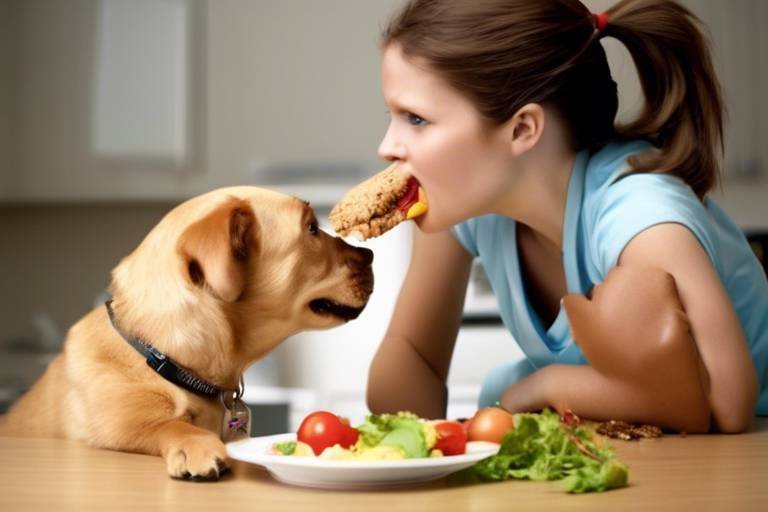Tips for Creating a Nutritional Diet for Dogs
Creating a nutritional diet for your furry friend is not just about filling their bowl with food; it’s about ensuring their health and happiness through proper nutrition. Just like us, dogs require a well-balanced diet to thrive, and understanding their specific needs can make a world of difference. So, how do you go about crafting the perfect meal plan for your dog? Let’s dive into the essentials!
Dogs have unique dietary requirements that vary based on their age, size, and activity level. For instance, a puppy's needs differ significantly from those of a senior dog. A growing puppy requires more protein and calories for development, while older dogs may need fewer calories to maintain a healthy weight. Knowing these differences is crucial for creating a balanced diet that promotes overall health.
A well-rounded diet for dogs includes proteins, fats, carbohydrates, vitamins, and minerals. Each nutrient plays a vital role in maintaining your dog's health and energy levels. For example, protein is essential for muscle development, while fats provide a concentrated energy source. Understanding the importance of each nutrient can help you formulate a diet that meets your dog's specific needs.
Protein is the building block of your dog's body. It is essential for muscle development, tissue repair, and overall growth. Choosing high-quality protein sources is key to meeting your dog's dietary needs. Think of protein as the fuel that keeps your dog's engine running smoothly. Without it, they may lack energy and vitality.
Common protein sources for dogs include:
- Chicken
- Beef
- Fish
- Plant-based proteins like lentils and chickpeas
Each source provides different benefits, so it's important to vary protein types in your dog's diet. For instance, fish is rich in omega-3 fatty acids, which are great for skin and coat health.
Puppies, adults, and senior dogs have different protein requirements. Puppies need around 22-32% of their diet to be protein, while adult dogs typically require about 18%. Senior dogs may need less, depending on their activity level and health. Understanding these differences helps in formulating an age-appropriate diet that supports their health.
Fats are a concentrated energy source for dogs and are essential for healthy skin and coat. Incorporating the right types of fats in their diet is crucial for optimal health. Think of fats as the oil that keeps the engine running smoothly. Without sufficient fats, your dog may experience dry skin, dull coat, and even energy slumps.
Carbohydrates provide energy and are a source of dietary fiber, which aids in digestion. Incorporating healthy carbohydrates can enhance your dog's overall diet and well-being. It's like adding the perfect seasoning to your favorite dish; it just makes everything better!
Opt for whole grains and vegetables as sources of carbohydrates. These options provide essential nutrients and promote better digestion in dogs. Some great choices include:
- Brown rice
- Oats
- Sweet potatoes
- Carrots
Fiber helps regulate digestion and can prevent obesity. Including fiber-rich foods in your dog's diet is essential for maintaining a healthy weight and digestive system. Think of fiber as the broom that sweeps out the digestive tract, ensuring everything runs smoothly.
Vitamins and minerals support various bodily functions in dogs, including immune health and bone strength. Ensuring adequate intake through diet or supplements is vital for their overall health. Just like a car needs different fluids to function properly, your dog needs a variety of nutrients to stay healthy.
Fruits and vegetables are excellent sources of vitamins. Incorporating a variety of these foods can enhance your dog's diet and provide essential nutrients. Some dog-friendly options include:
- Blueberries
- Spinach
- Pumpkin
Calcium, phosphorus, and potassium are crucial minerals for dogs. Understanding their importance helps in creating a balanced diet that supports bone health and metabolic functions. Think of minerals as the tiny gears in a machine that keep everything operating smoothly.
Deciding between homemade and commercial dog food involves understanding the pros and cons of each option. Both can provide balanced nutrition if formulated correctly. Homemade dog food allows for control over ingredients, ensuring high-quality nutrition tailored to your dog's needs. However, it requires careful planning to meet all nutritional requirements.
Homemade dog food allows for customization and control over ingredients, ensuring your dog gets the best nutrition possible. Yet, it requires careful planning to ensure all nutritional needs are met.
Commercial dog food offers convenience and is formulated to meet nutritional standards. Selecting high-quality brands ensures your dog receives balanced nutrition without the hassle of meal preparation.
Regularly monitoring your dog's weight is essential for maintaining their health. Adjusting their diet based on weight changes can prevent obesity and related health issues. Just like you wouldn’t ignore a check engine light in your car, you shouldn’t ignore your dog’s weight.
Recognizing signs of overweight dogs, such as difficulty in movement or excessive panting, helps in making timely dietary adjustments to promote a healthier weight. If your dog is struggling to keep up on walks, it may be time to reassess their diet.
Establishing a consistent feeding schedule can help regulate your dog's eating habits. This promotes better digestion and weight management, ensuring your dog remains healthy and happy. Think of it as setting a routine for yourself; it helps keep everything in check!
Q: How do I know if my dog is overweight?
A: Look for signs such as difficulty moving, excessive panting, or a noticeable lack of energy. You can also consult your veterinarian for a professional assessment.
Q: Can I feed my dog table scraps?
A: While some table scraps are safe, many human foods can be harmful to dogs. Always check which foods are safe before sharing.
Q: How often should I feed my dog?
A: Most adult dogs do well with two meals a day, while puppies may require three to four meals to support their growth.

Understanding Dog Nutritional Needs
When it comes to our furry friends, understanding their nutritional needs is crucial for ensuring they lead happy and healthy lives. Just like humans, dogs have specific dietary requirements that vary based on several factors, including age, size, and activity level. Tailoring their diet to meet these needs is not just a good idea; it's essential for their overall well-being.
For instance, a puppy has different nutritional demands compared to an adult dog or a senior dog. Puppies require a diet rich in proteins and fats to support their rapid growth and development, while adult dogs need a balanced intake to maintain their weight and energy levels. Senior dogs, on the other hand, may benefit from diets lower in calories but higher in fiber to support their aging bodies.
Moreover, the size of your dog plays a significant role in determining their nutritional needs. Small breed dogs often have faster metabolisms and may require higher calorie diets relative to their size, whereas large breed dogs need controlled calorie intake to prevent obesity and related health issues. It's like trying to fuel a tiny sports car versus a massive truck; both need the right kind of fuel, but the quantity and type differ significantly.
Another critical factor is the activity level of your dog. An active dog, such as a working breed or one that loves to play fetch, will need more calories and nutrients to sustain their energy levels compared to a more sedentary dog. This is where understanding your dog's lifestyle becomes vital in crafting their diet. You wouldn't feed a couch potato the same amount of food as a marathon runner, right?
To sum up, here are the key factors to consider when understanding your dog's nutritional needs:
- Age: Puppies, adults, and seniors all have different dietary requirements.
- Size: Nutritional needs vary greatly between small and large breeds.
- Activity Level: Active dogs require more calories and nutrients.
By taking the time to assess these factors, you can create a balanced diet that not only meets your dog's nutritional needs but also enhances their quality of life. Remember, a well-fed dog is a happy dog, and understanding their unique needs is the first step in providing them with the best care possible.
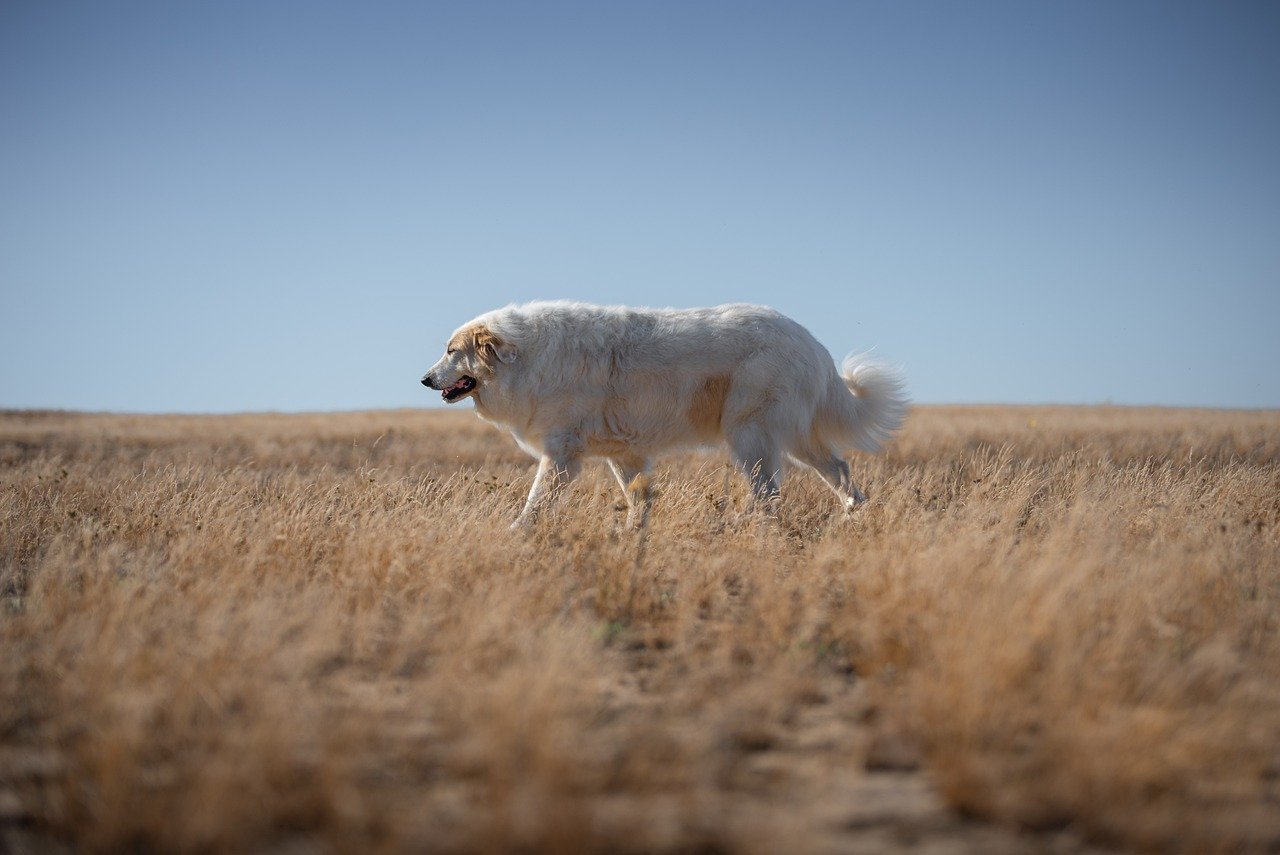
Essential Nutrients for Dogs
When it comes to keeping your furry friend healthy and happy, understanding their nutritional needs is paramount. A well-rounded diet for dogs is like a well-tuned engine; every part needs to work in harmony to ensure optimal performance. The essential nutrients for dogs include proteins, fats, carbohydrates, vitamins, and minerals. Each of these nutrients plays a crucial role in maintaining your dog’s overall health and energy levels.
Let's break it down a bit. Think of proteins as the building blocks of your dog's body. They are essential for muscle development, tissue repair, and overall growth. Just like how we need protein to recover after a workout, dogs require it to stay strong and active. High-quality protein sources, such as chicken, beef, and fish, should be included in their diet to meet these needs.
Next up are fats. These aren’t just the bad guys you might think of when it comes to human diets; for dogs, fats are a concentrated energy source and are vital for maintaining a healthy skin and coat. Think of fats as the fuel that keeps your dog’s engine running smoothly. However, it’s important to choose the right types of fats, such as omega-3 and omega-6 fatty acids, which can help promote a shiny coat and healthy skin.
Now, let’s talk about carbohydrates. These are often misunderstood, but they provide your dog with energy and are a source of dietary fiber, which aids in digestion. Including healthy carbohydrates like whole grains and vegetables can enhance your dog's overall diet and well-being. Just imagine how you feel after a hearty meal of whole grains versus a sugary snack—your dog feels the same way!
Speaking of digestion, fiber is an unsung hero in your dog’s diet. It helps regulate digestion and can prevent obesity, making it essential for maintaining a healthy weight. Fiber-rich foods like pumpkin and green beans can be great additions to your dog's meals. They not only help with digestion but also keep your dog feeling full and satisfied.
Finally, we can’t forget about vitamins and minerals. These micronutrients support various bodily functions, including immune health and bone strength. Ensuring your dog gets enough vitamins and minerals through their diet or supplements is vital for their overall health. Common sources of vitamins include fruits and vegetables, which can offer a plethora of nutrients. For minerals, calcium, phosphorus, and potassium are crucial for your dog's health, supporting everything from bone formation to metabolic functions.
| Nutrient | Function | Sources |
|---|---|---|
| Proteins | Muscle development, tissue repair | Chicken, beef, fish |
| Fats | Energy source, skin and coat health | Fish oil, flaxseed oil |
| Carbohydrates | Energy, digestion aid | Whole grains, vegetables |
| Vitamins | Support immune health | Fruits, vegetables |
| Minerals | Bone health, metabolic functions | Dairy, leafy greens |
In conclusion, understanding and incorporating these essential nutrients into your dog's diet is key to ensuring they live a long, healthy, and vibrant life. Just as you wouldn’t fuel your car with low-quality gas, you shouldn’t skimp on the quality of your dog’s food. Their health and happiness depend on it!
- What is the best protein source for dogs? High-quality sources like chicken, beef, and fish are excellent choices.
- Can dogs be vegetarian? Yes, but it requires careful planning to ensure they get all essential nutrients.
- How much should I feed my dog? This depends on their age, size, and activity level. Consult your vet for personalized advice.
- Is homemade dog food better than commercial? It can be, but it requires careful planning to meet all nutritional needs.
Importance of Protein
Protein is one of the most crucial components of your dog's diet. It serves as the building block for your dog's body, playing an essential role in muscle development, tissue repair, and overall growth. Just like humans, dogs need protein to maintain their strength and vitality. Without adequate protein, dogs can experience a range of health issues, from weakened muscles to a compromised immune system. Think of protein as the fuel that powers your dog's engine—without it, they simply can't function at their best.
When considering your dog's diet, it's important to recognize that not all protein sources are created equal. High-quality proteins contain essential amino acids that are vital for your dog's health. These amino acids help in various bodily functions, including hormone production and enzyme activity. A diet rich in quality protein can lead to a shiny coat, healthy skin, and improved energy levels. So, what are some of the benefits of ensuring your dog gets enough protein?
- Muscle Development: Protein is essential for building and maintaining muscle mass, crucial for active dogs.
- Tissue Repair: After injuries or intense exercise, protein aids in the recovery of damaged tissues.
- Immune Function: A protein-rich diet supports a healthy immune system, helping your dog fight off illnesses.
- Energy Levels: Protein contributes to sustained energy, allowing your dog to stay active and playful.
It's also important to consider the age and activity level of your dog when determining their protein needs. Puppies, for instance, require more protein than adult dogs to support their rapid growth and development. On the other hand, senior dogs may need a slightly lower protein intake but still require high-quality sources to maintain their muscle mass and overall health. Understanding these differences ensures that you provide an age-appropriate diet that supports your dog's unique needs.
In summary, protein is not just a dietary component; it's a fundamental element that supports your dog's overall health and well-being. By choosing high-quality protein sources and understanding your dog's specific needs, you can help them thrive and live a long, healthy life. Remember, a well-nourished dog is a happy dog!
1. How much protein should my dog have in their diet?
The amount of protein your dog needs can vary based on their age, size, and activity level. Generally, adult dogs should have about 18-25% protein in their diet, while puppies may require around 22-32%. It's best to consult with your veterinarian for personalized recommendations.
2. Can dogs get enough protein from plant-based sources?
Yes, dogs can obtain protein from plant-based sources, but it's important to ensure that these sources provide all essential amino acids. Combining different plant proteins, such as legumes and grains, can help achieve a balanced amino acid profile.
3. What are some high-quality protein sources for dogs?
Some excellent sources of protein for dogs include chicken, beef, fish, eggs, and certain plant-based options like lentils and chickpeas. Always choose high-quality, lean meats and avoid processed meats that may contain additives.
4. Is too much protein harmful to dogs?
While protein is essential, excessive protein intake can lead to health issues, particularly in dogs with kidney problems. It's important to provide a balanced diet and consult with your veterinarian if you have concerns about your dog's protein intake.
Sources of Protein
When it comes to providing your furry friend with the best nutrition, protein is a key player in the game. It serves as the building block for your dog's muscles, skin, and overall health. But where can you find the best protein sources for your pup? Let's dive into some of the most popular options!
First up, we have animal-based proteins. These are often considered the gold standard in canine nutrition. Here are a few top contenders:
- Chicken: This lean meat is not only tasty but also packed with essential amino acids that support muscle growth and repair.
- Beef: Rich in iron and zinc, beef provides a hearty protein source that can help maintain your dog's energy levels.
- Fish: Fish, especially salmon, is loaded with omega-3 fatty acids, which promote a shiny coat and healthy skin.
But don't forget about plant-based proteins! While they might not have the same amino acid profile as animal proteins, they can still be valuable additions to your dog's diet. Some great options include:
- Quinoa: A complete protein that contains all nine essential amino acids, quinoa is a fantastic grain alternative.
- Peas: High in protein and fiber, peas can help keep your dog full and satisfied.
- Lentils: These legumes are not only protein-rich but also loaded with vitamins and minerals.
It's important to remember that variety is the spice of life! Mixing different protein sources not only keeps your dog's meals interesting but also ensures they receive a well-rounded diet. For instance, combining chicken with lentils can provide a complete amino acid profile and add a delightful twist to your dog's mealtime.
Additionally, when selecting protein sources, always opt for high-quality ingredients. Look for options that are free from fillers and artificial additives. The better the quality of the protein, the more beneficial it will be for your dog's health.
In conclusion, whether you choose animal-based or plant-based proteins, the key is to provide a diverse and balanced diet. By incorporating a variety of protein sources, you can help ensure your dog thrives and enjoys every bite!
Q: How much protein does my dog need?
A: The amount of protein your dog needs depends on their age, size, and activity level. Generally, adult dogs require about 18-25% protein in their diet, while puppies may need up to 30%.
Q: Can I feed my dog a vegetarian diet?
A: Yes, dogs can thrive on a vegetarian diet, but it's essential to ensure they receive all necessary nutrients. Consulting with a veterinarian or a pet nutritionist can help you formulate a balanced vegetarian diet.
Q: Are there any protein sources I should avoid?
A: It's best to avoid protein sources that are high in fillers and artificial additives. Additionally, some dogs may have allergies to certain proteins, such as beef or chicken, so it's crucial to monitor your dog for any adverse reactions.
Protein Requirements by Age
When it comes to protein requirements, age plays a pivotal role in determining how much your dog needs. Just like humans, dogs experience different life stages, and their nutritional needs evolve accordingly. Understanding these variations is essential for formulating a diet that supports their growth, maintenance, and overall health.
For puppies, the protein requirement is significantly higher because they are in a crucial stage of growth and development. During this time, their bodies are rapidly building muscles and tissues, so they need around 22-32% of their daily calories from protein. This high protein intake helps in developing strong bones and muscles, setting the foundation for a healthy adult dog. You can consider including protein sources like chicken, turkey, and fish in their meals to meet these needs.
As dogs transition into the adult stage, typically around one year of age, their protein requirements decrease but remain substantial. Adult dogs generally need about 18-25% of their daily calories from protein. This amount is sufficient to maintain muscle mass and support overall bodily functions. It's important to continue providing high-quality protein sources, but you can start to incorporate a variety of meats, including beef and lamb, to keep their diet interesting and nutritious.
For senior dogs, the protein requirement can vary based on their health status and activity levels. While some may still need around 18-25%, others, especially those that are less active or have health issues, might require a lower protein intake to avoid stress on their kidneys. However, it's crucial to ensure that the protein they do consume is of high quality to support muscle maintenance and overall health. Consult your veterinarian to tailor the protein content according to your senior dog's specific needs.
| Life Stage | Protein Requirement (% of Daily Calories) | Key Protein Sources |
|---|---|---|
| Puppy | 22-32% | Chicken, Turkey, Fish |
| Adult | 18-25% | Beef, Lamb, Chicken |
| Senior | 18-25% (may vary) | High-quality meats, Fish |
In conclusion, understanding your dog's protein requirements based on their age is crucial for maintaining their health and vitality. Adjusting their diet to meet these needs ensures they receive the right balance of nutrients at every stage of their life. Always remember to consult with your veterinarian for personalized dietary advice tailored to your dog's unique needs.
- How do I know if my dog is getting enough protein? Regular vet check-ups and monitoring your dog's weight and muscle condition can help you determine if they're receiving adequate protein.
- Can too much protein harm my dog? Yes, excessive protein can strain your dog's kidneys, especially in senior dogs or those with pre-existing health conditions.
- What are the best protein sources for dogs? High-quality meats such as chicken, beef, and fish, along with some plant-based proteins, are excellent sources.
The Role of Fats
When it comes to your dog's diet, fats play a pivotal role that often goes unnoticed. Think of fats as the fuel that powers your furry friend’s energy levels. Just like how a car needs gas to run smoothly, dogs require fats for optimal performance. But it’s not just about energy; fats are essential for maintaining healthy skin and a shiny coat. They also help in the absorption of fat-soluble vitamins like A, D, E, and K, which are crucial for your dog’s overall health.
But not all fats are created equal. The quality of fat in your dog’s diet can significantly impact their well-being. Healthy fats, such as those found in fish oil or flaxseed oil, provide essential fatty acids like Omega-3 and Omega-6. These fatty acids are known for their anti-inflammatory properties and can support joint health, brain function, and even improve your dog’s mood. Just imagine your dog bounding through the park, full of energy and vitality—that’s the power of good fats!
However, it’s important to strike a balance. Too much fat can lead to obesity and other health issues. A good rule of thumb is to ensure that fats make up about 10-15% of your dog's total diet. This can vary depending on your dog's age, size, and activity level, so always consult with your veterinarian when making dietary changes.
To help you understand the types of fats that are beneficial for your dog, here’s a quick overview:
| Type of Fat | Source | Benefits |
|---|---|---|
| Omega-3 Fatty Acids | Fish oil, flaxseed oil | Reduces inflammation, supports joint health |
| Omega-6 Fatty Acids | Chicken fat, sunflower oil | Promotes healthy skin and coat |
| Saturated Fats | Beef fat, coconut oil | Provides energy, but should be consumed in moderation |
Incorporating the right types of fats into your dog’s diet can be a game-changer. Always remember to introduce any dietary changes gradually to avoid upsetting their stomach. The goal is to create a balanced diet that not only meets their energy needs but also supports their overall health and happiness. So, next time you’re choosing food for your four-legged friend, don’t overlook the importance of fats—they’re a vital part of the recipe for a healthy, happy dog!
- What types of fats should I avoid in my dog's diet? Avoid trans fats and excessive saturated fats, which can contribute to health issues.
- How can I tell if my dog is getting enough fats? A healthy coat and skin, along with good energy levels, are signs that your dog is getting the right amount of fats.
- Can I use human oils for my dog's diet? Yes, certain human oils like olive oil and coconut oil can be beneficial, but always consult your vet first.
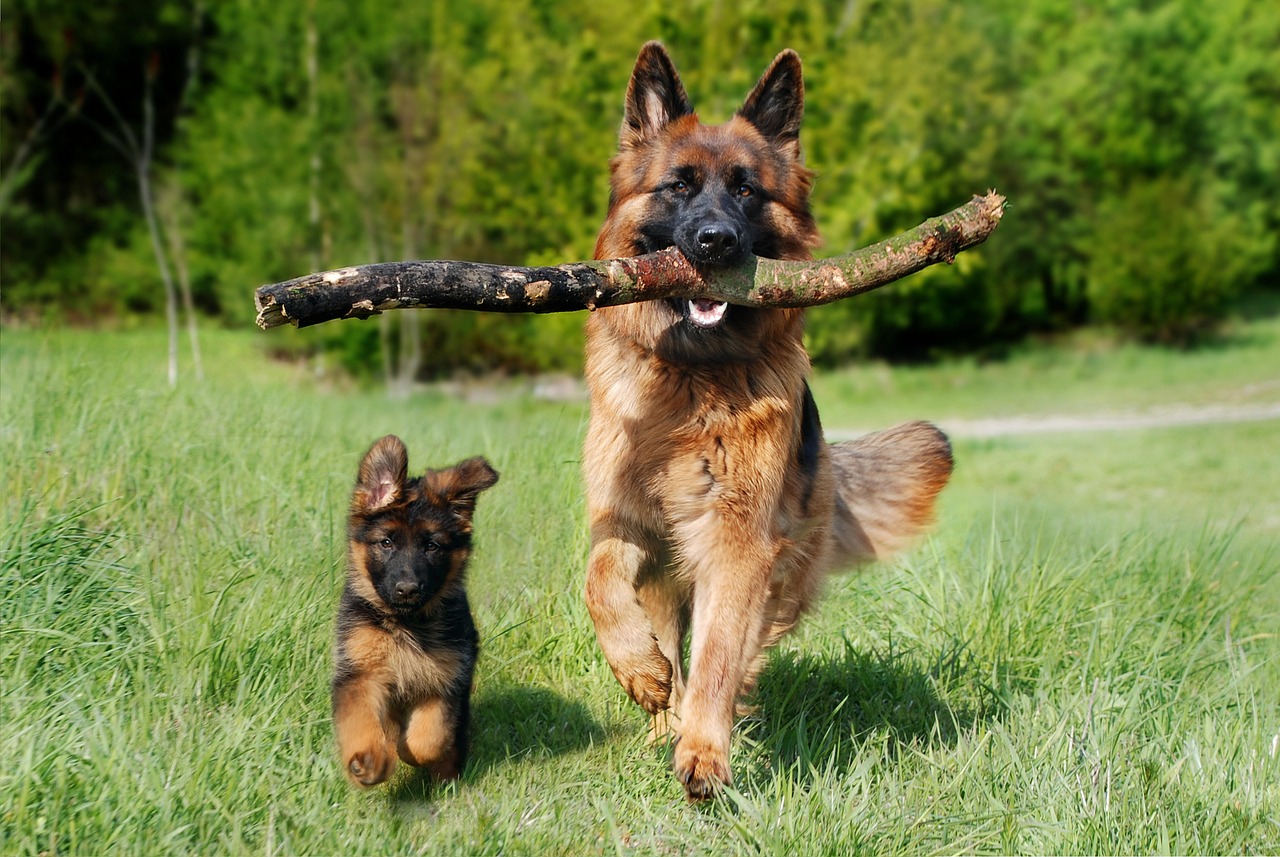
Carbohydrates and Fiber
When it comes to your dog's diet, carbohydrates and fiber play a pivotal role in maintaining their energy levels and digestive health. Think of carbohydrates as the fuel that powers your dog’s daily activities. Just like a car needs gasoline to run, your furry friend needs carbohydrates to keep their energy levels high and their spirits even higher. However, not all carbs are created equal, and choosing the right sources can make a significant difference in your dog's overall well-being.
Carbohydrates are primarily found in grains, fruits, and vegetables. They serve as an essential energy source, which is particularly important for active dogs. When selecting carbohydrates for your dog's diet, it's crucial to focus on whole grains and vegetables rather than refined grains or fillers. Whole grains, such as brown rice and oats, provide not only energy but also a wealth of nutrients. Vegetables like sweet potatoes and peas are also fantastic choices, offering vitamins and minerals while being low in calories.
Now, let’s talk about fiber. This often-overlooked nutrient is vital for digestion. Just as a well-oiled machine runs smoothly, a diet rich in fiber ensures that your dog's digestive system operates efficiently. Fiber helps to regulate bowel movements, preventing issues like constipation or diarrhea. Additionally, it can aid in weight management by promoting a feeling of fullness, which can be particularly beneficial if your dog is prone to overeating.
Including fiber-rich foods in your dog's diet can be as simple as adding a few servings of fruits and vegetables. Some great sources of fiber include:
- Carrots
- Green beans
- Apples (without seeds)
- Pumpkin
Incorporating these foods not only enhances your dog's diet but also adds variety and flavor, making mealtime more enjoyable. However, it's essential to introduce new foods gradually to avoid any digestive upset. Just like humans, dogs can experience a change in their gut flora when their diets shift, so moderation is key.
To give you a clearer picture of how carbohydrates and fiber can benefit your dog, here’s a quick comparison:
| Nutrient | Benefits | Sources |
|---|---|---|
| Carbohydrates | Provides energy and supports overall health | Brown rice, oats, sweet potatoes, peas |
| Fiber | Aids digestion, helps maintain healthy weight | Carrots, green beans, apples, pumpkin |
In summary, ensuring that your dog's diet includes healthy carbohydrates and fiber is essential for their energy levels and digestive health. By making informed choices about the types of carbohydrates and fiber you include in their meals, you can help your dog lead a happier, healthier life. Remember, a well-balanced diet is the foundation of good health, and your dog deserves the best!
Q: Can dogs eat all types of carbohydrates?
A: Not all carbohydrates are suitable for dogs. It's best to stick to whole grains and vegetables while avoiding refined grains and fillers.
Q: How much fiber does my dog need?
A: The amount of fiber can vary based on your dog's size and dietary needs, but a general guideline is about 2-5% of their diet should be fiber.
Q: Are there any signs my dog needs more fiber?
A: If your dog is experiencing irregular bowel movements or seems to be gaining weight despite a controlled diet, they may benefit from more fiber.
Choosing Healthy Carbohydrates
When it comes to your dog's diet, carbohydrates can often be overlooked, but they play a crucial role in providing the energy your furry friend needs to stay active and healthy. Not all carbohydrates are created equal, and choosing the right ones is essential for maintaining your dog's overall well-being. So, what should you look for when selecting healthy carbohydrates for your pup?
First and foremost, opt for whole grains and vegetables as your primary sources of carbohydrates. Whole grains, such as brown rice, oats, and quinoa, are packed with essential nutrients and fiber, which can aid in digestion and help your dog feel fuller for longer. Vegetables like sweet potatoes, carrots, and peas not only provide carbohydrates but are also rich in vitamins and minerals that contribute to a balanced diet.
It's important to avoid refined grains and fillers often found in commercial dog foods, such as corn and wheat. These ingredients can lead to spikes in blood sugar levels and may not provide the necessary nutritional benefits that whole foods do. Instead, focus on incorporating a variety of healthy carbohydrates into your dog's meals. Here’s a quick breakdown of some great options:
| Carbohydrate Source | Benefits |
|---|---|
| Brown Rice | High in fiber and helps with digestion. |
| Sweet Potatoes | Rich in vitamins A and C, and a great source of energy. |
| Oats | Good for heart health and provides sustained energy. |
| Carrots | Low in calories and high in fiber, great for dental health. |
Incorporating these healthy carbohydrates into your dog's diet can enhance their energy levels and contribute to a shiny coat and healthy skin. Remember, moderation is key! Too many carbohydrates can lead to weight gain, so always consult with your veterinarian to determine the right balance for your dog's specific needs.
By choosing the right carbohydrates, you're not just filling your dog's bowl; you're fueling their adventures and ensuring they lead a happy, healthy life. After all, a well-nourished dog is a happy dog!
- What are the best carbohydrate sources for dogs? Whole grains like brown rice and oats, as well as vegetables like sweet potatoes and carrots, are excellent sources of carbohydrates.
- Should dogs eat grains? Yes, many dogs can benefit from whole grains as part of a balanced diet, but it's essential to avoid refined grains.
- How much carbohydrate should I include in my dog's diet? The amount can vary based on your dog's size, age, and activity level. It's best to consult your veterinarian for personalized advice.
Importance of Fiber
When it comes to your dog's diet, fiber often doesn’t get the attention it deserves. However, it plays a crucial role in maintaining your furry friend's health. Just like humans, dogs need fiber to regulate their digestive systems. It acts like a broom, sweeping through the intestines and helping to keep everything moving smoothly. Without adequate fiber, your dog might face digestive issues such as constipation or diarrhea, which can lead to discomfort and health problems.
Fiber is not just about keeping things moving; it also aids in weight management. If your dog is prone to obesity, incorporating fiber-rich foods can help them feel full without adding too many calories. Think of fiber as nature’s way of providing a low-calorie filler to your dog's meals. This means they can enjoy their food while still maintaining a healthy weight. Foods high in fiber, such as pumpkin, sweet potatoes, and green beans, can be great additions to their diet.
Moreover, fiber is essential for promoting a healthy gut microbiome. A balanced gut flora is vital for nutrient absorption and overall immune function. You might be wondering how fiber contributes to this. Well, it serves as a food source for beneficial gut bacteria, allowing them to thrive and keep harmful bacteria in check. This is particularly important for dogs, as a healthy gut can lead to a happier, more energetic pet.
Here’s a quick breakdown of the benefits of fiber for your dog:
- Improves Digestion: Helps prevent constipation and diarrhea.
- Aids in Weight Control: Promotes a feeling of fullness.
- Supports Gut Health: Nourishes beneficial gut bacteria.
- Regulates Blood Sugar: Slows down the absorption of sugar.
Incorporating fiber into your dog's diet doesn’t have to be complicated. You can start by adding small amounts of high-fiber foods gradually to their meals. Just like introducing a new toy, it's important to do it slowly to avoid any digestive upset. Always monitor your dog's reaction to these changes and consult your veterinarian if you have any concerns.
In conclusion, fiber is a vital component of a balanced diet for dogs. It not only aids in digestion but also helps in managing weight and supporting overall health. So, the next time you're planning your dog's meals, don’t forget to sprinkle in some fiber-rich foods to keep their tummy happy and healthy!
Q: How much fiber should my dog have daily?
A: The amount of fiber varies based on your dog's size and dietary needs, but a general guideline is about 2-5% of their total diet. Always consult with your vet for personalized advice.
Q: Can I give my dog human foods for fiber?
A: Yes, many human foods are safe for dogs and high in fiber, such as pumpkin, carrots, and green beans. Always ensure they are prepared without added sugars or seasonings.
Q: What are the signs that my dog needs more fiber?
A: If your dog is experiencing irregular bowel movements, such as constipation or diarrhea, it might be a sign they need more fiber in their diet. Monitor their eating habits and consult your vet if you have concerns.

Vitamins and Minerals
When it comes to keeping our furry friends healthy, play an indispensable role in their overall well-being. These essential nutrients support a variety of bodily functions, including immune health, bone strength, and even energy metabolism. Just like humans, dogs require a balanced intake of vitamins and minerals to thrive, and understanding their specific needs can make a world of difference in your pup's health.
Vitamins are organic compounds that are crucial for many physiological functions. Dogs primarily need vitamins A, B, C, D, E, and K. Each of these vitamins has unique benefits:
- Vitamin A: Important for vision, skin health, and immune function.
- Vitamin B Complex: Supports energy production and brain function.
- Vitamin C: Acts as an antioxidant and supports the immune system.
- Vitamin D: Crucial for calcium absorption, impacting bone health.
- Vitamin E: An antioxidant that promotes skin health and immune function.
- Vitamin K: Essential for blood clotting and bone health.
Minerals, on the other hand, are inorganic elements that also contribute significantly to your dog's health. Key minerals include calcium, phosphorus, potassium, and magnesium, each serving vital roles:
- Calcium: Essential for strong bones and teeth.
- Phosphorus: Works in tandem with calcium for bone health and energy production.
- Potassium: Important for muscle function and maintaining a healthy heart.
- Magnesium: Supports muscle and nerve function, as well as energy production.
To ensure your dog is getting enough vitamins and minerals, consider incorporating a variety of fruits and vegetables into their diet. Foods like carrots, spinach, blueberries, and sweet potatoes are not only delicious but also packed with the nutrients your dog needs. However, it's important to remember that not all human foods are safe for dogs, so always do your research or consult with a veterinarian before introducing new foods.
Additionally, if your dog is on a commercial diet, it's worth checking the label to ensure that it meets the AAFCO (Association of American Feed Control Officials) standards for complete and balanced nutrition. These standards help guarantee that the food provides all the necessary vitamins and minerals for your dog's specific life stage.
In some cases, especially if your dog has specific health concerns or dietary restrictions, supplements might be necessary. However, it's crucial to consult with your veterinarian before starting any supplementation, as excessive intake of certain vitamins and minerals can lead to toxicity and health issues.
Q: Can I give my dog human vitamins?
A: It's not recommended to give dogs human vitamins without veterinary guidance, as some human vitamins can be harmful to pets.
Q: How can I tell if my dog is getting enough vitamins and minerals?
A: A healthy coat, good energy levels, and overall vitality are signs your dog is likely receiving adequate nutrition. Regular vet check-ups can provide more specific insights.
Q: Are there any dog-safe fruits and vegetables I can add to my dog's diet?
A: Yes! Carrots, blueberries, pumpkin, and spinach are great options. Always introduce new foods gradually and consult with your vet.
Common Vitamin Sources
When it comes to ensuring your furry friend gets the essential vitamins they need for optimal health, fruits and vegetables are your best allies. These natural foods are not just tasty treats; they're packed with vitamins that support various bodily functions in dogs. For instance, carrots are rich in vitamin A, which is crucial for maintaining good vision and a healthy immune system. Similarly, spinach is a powerhouse of vitamins K, C, and E, all of which contribute to overall health and vitality.
But wait, there’s more! Blueberries are another fantastic addition to your dog’s diet. They are loaded with antioxidants and vitamin C, which can help combat free radicals in your dog's body. Plus, they make for a delicious snack! Incorporating a variety of these foods not only enhances your dog’s diet but also keeps their meals exciting and flavorful.
To give you a clearer picture, here’s a quick table summarizing some common vitamin sources and the vitamins they provide:
| Food Source | Vitamins |
|---|---|
| Carrots | Vitamin A |
| Spinach | Vitamins K, C, and E |
| Blueberries | Vitamin C |
| Sweet Potatoes | Vitamins A and C |
| Bananas | Vitamin B6 and C |
It's important to remember that while these vitamin sources are beneficial, moderation is key. Too much of a good thing can lead to digestive upset or other health issues. Always introduce new foods gradually and consult with your veterinarian to ensure that your dog's diet remains balanced and nutritious.
- What fruits and vegetables are safe for dogs? Most fruits and vegetables are safe, but avoid grapes, raisins, and onions, as they can be toxic.
- How can I tell if my dog is getting enough vitamins? Signs include a shiny coat, good energy levels, and overall health. If you notice changes, consult your vet.
- Can I give my dog vitamin supplements? Yes, but only under the guidance of a veterinarian to avoid overdosing on certain vitamins.
Mineral Requirements
When it comes to keeping your furry friend healthy, minerals play a crucial role in their overall well-being. Just like humans, dogs require a variety of minerals to support various bodily functions. Among the most essential minerals for dogs are calcium, phosphorus, and potassium. These minerals not only contribute to strong bones and teeth but also play significant roles in metabolic processes and muscle function.
Calcium is vital for developing and maintaining strong bones and teeth, especially in growing puppies. A deficiency in calcium can lead to serious health issues, such as bone deformities and increased risk of fractures. On the other hand, phosphorus works hand-in-hand with calcium to ensure proper bone structure. The balance between these two minerals is essential; too much phosphorus can hinder calcium absorption, leading to potential health problems.
Potassium, another key mineral, helps regulate fluid balance, muscle contractions, and nerve signals. A deficiency in potassium can lead to weakness and fatigue, which can significantly affect your dog's energy levels and overall health. To ensure your dog gets enough of these essential minerals, consider incorporating the following foods into their diet:
- Calcium Sources: Dairy products like yogurt and cheese, leafy greens, and fish with bones.
- Phosphorus Sources: Meat, poultry, fish, and eggs.
- Potassium Sources: Sweet potatoes, bananas, and spinach.
It's important to note that while minerals are essential, they should be provided in the right amounts. Too much of a good thing can be detrimental. For instance, excessive calcium can lead to kidney issues or urinary problems. Therefore, consulting with a veterinarian is highly recommended to tailor your dog's diet to meet their specific mineral needs.
In summary, ensuring that your dog receives the right balance of minerals is a fundamental aspect of their diet. When you pay attention to their mineral requirements, you're not just feeding them; you're investing in their long-term health and happiness. So, keep an eye on their meals and watch how these little changes can make a big difference in their lives!
1. How can I tell if my dog is getting enough minerals?
Look for signs of good health, such as shiny coats, healthy teeth, and active behavior. If you notice any signs of lethargy or poor coat condition, consult your vet.
2. Can I give my dog mineral supplements?
While supplements can be beneficial, it's best to consult with a veterinarian before adding them to your dog's diet to avoid any imbalances.
3. Are there specific foods I should avoid when it comes to minerals?
Avoid overly processed foods, as they often lack essential nutrients, including minerals. Always opt for high-quality dog food that meets AAFCO standards.
4. How often should I feed my dog foods rich in minerals?
Incorporate mineral-rich foods regularly into your dog's diet, but balance them with other nutrients to ensure a well-rounded meal plan.
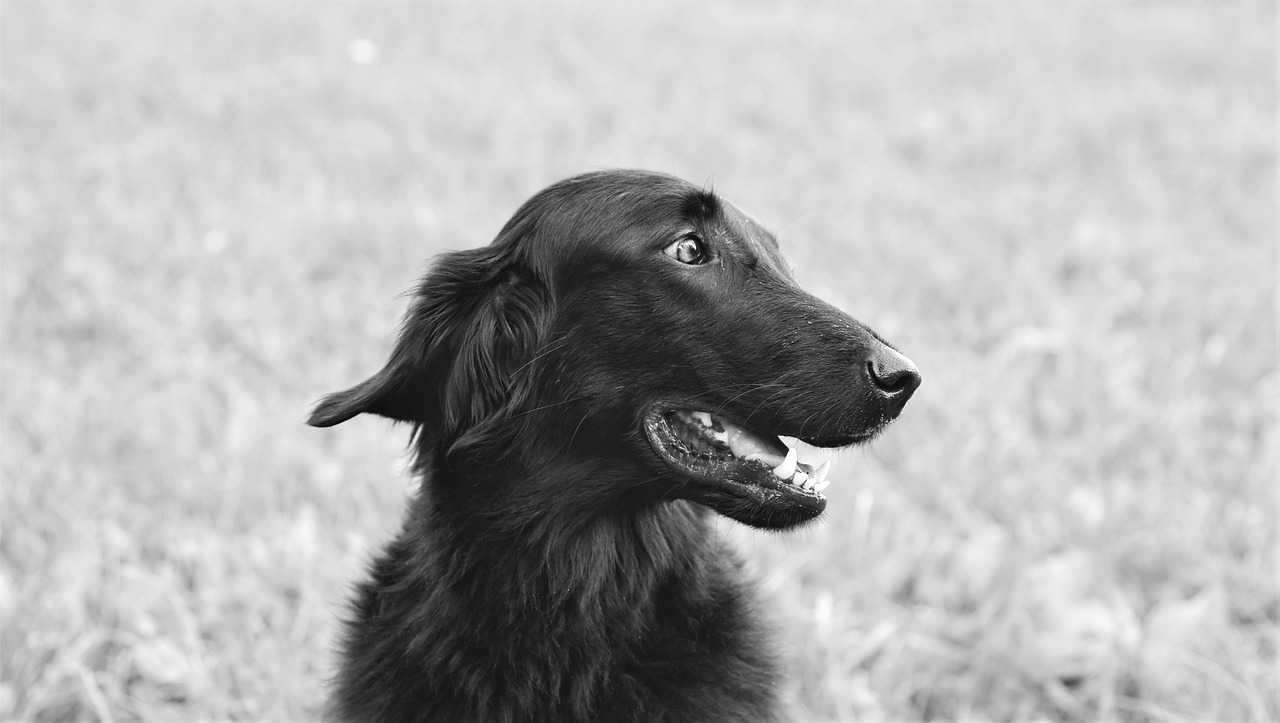
Homemade vs. Commercial Dog Food
When it comes to feeding your furry friend, the debate between homemade and commercial dog food is one that many pet owners grapple with. Each option has its own set of advantages and disadvantages, and understanding these can help you make an informed choice that best suits your dog's needs. Let's dive into the details!
Homemade dog food is often touted for its quality control. When you prepare your dog's meals at home, you have the power to select every ingredient, ensuring that they are fresh and free from fillers and artificial additives. This can be particularly beneficial for dogs with food allergies or specific dietary restrictions. However, creating a balanced homemade diet requires careful planning and knowledge of canine nutrition. You must ensure that you're providing all the necessary nutrients, which can be quite a challenge!
On the other hand, commercial dog food offers a level of convenience that can't be overlooked. Most commercial brands are formulated to meet the nutritional standards set by veterinary associations, which means they are designed to provide a balanced diet. The convenience of simply opening a bag or can and serving it is appealing, especially for busy pet owners. However, not all commercial dog foods are created equal. Some may contain low-quality ingredients or excessive fillers that don't contribute to your dog's health.
To help you weigh the pros and cons, here’s a quick comparison:
| Aspect | Homemade Dog Food | Commercial Dog Food |
|---|---|---|
| Ingredient Control | High - You choose everything | Varies - Depends on brand |
| Convenience | Low - Requires preparation | High - Ready to serve |
| Nutritional Balance | Can be challenging to achieve | Generally balanced if high-quality |
| Cost | Can be more expensive | Usually more economical |
Ultimately, the choice between homemade and commercial dog food should be based on your dog's individual needs, your lifestyle, and your budget. If you decide to go the homemade route, consider consulting with a veterinarian or a pet nutritionist to ensure you're meeting all of your dog's dietary requirements. On the flip side, if you opt for commercial food, take the time to research brands and read labels carefully to select high-quality options.
- Can I mix homemade and commercial dog food? Yes, many pet owners choose to do this to provide variety and balance, but it’s important to ensure that the overall diet remains nutritionally complete.
- How do I know if my dog is getting enough nutrients? Regular vet check-ups can help monitor your dog's health and nutritional status, and they can guide you on dietary adjustments if needed.
- Is homemade dog food more expensive? It can be, especially if you use high-quality ingredients, but it also depends on the recipes you choose and your location.
Benefits of Homemade Dog Food
When it comes to feeding our furry friends, the choice between homemade and commercial dog food can be a tough one. However, opting for homemade dog food comes with a plethora of benefits that can significantly enhance your dog's health and well-being. One of the most prominent advantages is the control over ingredients. When you prepare your dog's meals at home, you have the power to choose only high-quality ingredients, ensuring that your dog is not consuming any fillers or artificial additives that are often found in commercial products.
Another significant benefit is the ability to tailor the diet specifically to your dog's unique needs. Just like humans, dogs have different dietary requirements based on their size, age, and health conditions. For example, if your dog has allergies or sensitivities to certain foods, making meals at home allows you to avoid those ingredients altogether. This customization can lead to improved digestion and overall health, making your pup feel more energetic and vibrant.
Moreover, preparing homemade dog food can be a fun and rewarding experience. It allows you to bond with your pet as you create meals that they will love. You can experiment with various recipes, introducing new flavors and textures that keep mealtime exciting. This not only keeps your dog interested in their food but also ensures that they are receiving a well-rounded diet rich in diverse nutrients.
It's also worth mentioning that homemade dog food can be more cost-effective in the long run. While the initial investment in quality ingredients might seem high, the potential savings on vet bills due to improved health can be substantial. By ensuring your dog receives a balanced diet, you can help prevent health issues related to poor nutrition, such as obesity, diabetes, or digestive problems.
Lastly, homemade dog food can foster a sense of satisfaction in pet owners, knowing that they are providing their beloved companions with the best possible nutrition. However, it's crucial to do your homework and ensure that the meals are nutritionally complete. Consulting with a veterinarian or a pet nutritionist can help you formulate a balanced diet that meets all of your dog's nutritional needs.
- Is homemade dog food better than commercial dog food?
It depends on the quality of the ingredients and whether the homemade food meets all of your dog's nutritional needs. Many pet owners find that homemade food provides better control over ingredients and can be tailored to individual health needs. - Can I use leftovers for my dog's meals?
While using leftovers can be a great way to reduce waste, it’s essential to ensure that they are safe for dogs to consume. Avoid foods that are toxic to dogs, such as onions, garlic, and chocolate. - How do I ensure my homemade dog food is balanced?
Consulting with a veterinarian or a pet nutritionist can help you create a balanced diet for your dog. There are also numerous resources available that provide guidelines on the essential nutrients your dog needs.
Choosing Commercial Dog Food
When it comes to , the options can feel overwhelming. With so many brands, flavors, and formulations available, how do you know which one is the best for your furry friend? The first step is to look for products that meet the standards set by the Association of American Feed Control Officials (AAFCO). This ensures that the food is nutritionally complete and balanced for your dog's specific life stage.
Next, it's crucial to read the ingredient list. Ingredients are typically listed in descending order by weight, so the first few items should ideally include a high-quality source of protein, such as chicken or beef. Avoid products that list fillers like corn or soy as primary ingredients, as these do not provide the essential nutrients your dog needs. Instead, opt for foods that contain whole grains, vegetables, and healthy fats, which contribute to your dog’s overall health.
Another important factor to consider is your dog's unique needs. For instance, if your dog has food allergies or sensitivities, you may want to choose a limited-ingredient diet that minimizes potential allergens. Alternatively, senior dogs may benefit from food formulated specifically for their age group, which often contains lower calories and added joint support.
To help you navigate the vast array of options, here’s a quick comparison of different types of commercial dog food:
| Type of Dog Food | Pros | Cons |
|---|---|---|
| Dry Kibble | Convenient, cost-effective, helps clean teeth | May contain fillers, less palatable for picky eaters |
| Canned Food | High moisture content, often more appealing | More expensive, can lead to dental issues if fed exclusively |
| Raw Diet | Natural, high protein, promotes healthy coat | Risk of bacterial contamination, requires careful handling |
| Freeze-Dried Food | Convenient, retains nutrients, easy to store | Can be pricey, requires rehydration before feeding |
Finally, don’t forget to consider your dog's taste preferences. Sometimes, it may take a bit of trial and error to find a food that your dog absolutely loves. Remember, a happy dog is a healthy dog, and their enjoyment of their meals is an important part of their overall well-being. Always transition to a new food gradually to avoid any digestive issues, mixing it with the old food over the course of a week.
In conclusion, choosing the right commercial dog food is a vital step in ensuring your dog lives a long, healthy, and happy life. By paying attention to ingredients, nutritional needs, and your dog’s preferences, you can make an informed decision that benefits both you and your beloved pet.
- What should I look for in dog food ingredients? Look for high-quality protein sources listed first, followed by whole grains and vegetables. Avoid fillers and artificial additives.
- How do I transition my dog to a new food? Gradually mix the new food with the old food over 7-10 days to avoid digestive upset.
- Can I feed my dog a vegetarian diet? Yes, but it’s important to ensure that the diet is balanced and meets all of your dog’s nutritional needs.
- Is it better to feed my dog dry or wet food? It depends on your dog's preferences and needs. Dry food is convenient and helps with dental health, while wet food can be more palatable and hydrating.

Monitoring Your Dog's Weight
Keeping an eye on your dog's weight is not just about aesthetics; it's a matter of health and well-being. Just like humans, dogs can suffer from obesity, which can lead to a myriad of health issues such as diabetes, joint problems, and heart disease. Regular weight monitoring is essential to ensure your furry friend stays in tip-top shape. But how do you go about it? Let's dive into some practical tips and tricks!
First off, it's important to understand that every dog is unique. Factors such as breed, age, and activity level can significantly influence your dog's ideal weight. For instance, a Golden Retriever will have a different weight range compared to a Chihuahua. To help you get a better grasp, here’s a simple weight chart that provides a general guideline based on breed size:
| Dog Size | Ideal Weight Range |
|---|---|
| Small (up to 20 lbs) | 5 - 20 lbs |
| Medium (21 - 50 lbs) | 21 - 50 lbs |
| Large (51 - 90 lbs) | 51 - 90 lbs |
| Giant (over 90 lbs) | Over 90 lbs |
Next, you should regularly weigh your dog. This can be done at home using a scale or during routine vet visits. If you're weighing at home, make sure to weigh yourself first, then weigh yourself holding your dog, and subtract the difference. It's a simple trick that can help you keep track of their weight without too much hassle!
But weight isn't the only indicator of your dog's health. You should also look for physical signs of weight issues. Here are a few things to watch for:
- Rib Check: You should be able to feel your dog's ribs without too much pressure. If you can't, they may be overweight.
- Waistline: When viewed from above, your dog should have a noticeable waist. If they appear more oval than hourglass, it might be time to rethink their diet.
- Energy Levels: Is your dog less active than usual? Weight gain can lead to lethargy, so keep an eye on their playfulness.
Creating a feeding schedule can also play a significant role in weight management. Dogs thrive on routine, and having set meal times helps regulate their appetite. Consider splitting their daily food intake into two or three meals instead of leaving food out all day. This not only helps in managing their weight but also aids digestion.
Lastly, don't forget to consult with your veterinarian. They can provide personalized advice tailored to your dog's specific needs. Regular check-ups will ensure that any weight gain or loss is addressed promptly, keeping your pup healthy and happy.
1. How often should I weigh my dog?
It's a good idea to weigh your dog at least once a month. If your dog is on a weight loss journey, weekly weigh-ins may be beneficial.
2. What should I do if my dog is overweight?
Start by adjusting their diet and increasing their exercise. Consult your vet for a tailored weight loss plan.
3. Can I feed my dog table scraps?
While some human foods are safe for dogs, many are not. It's best to stick to dog-specific foods unless advised otherwise by your vet.
4. How can I tell if my dog is underweight?
If you can see your dog's ribs easily or feel their spine without any fat covering, they may be underweight. Consult your vet for further evaluation.
Signs of Overweight Dogs
Just like humans, dogs can struggle with their weight, and it’s crucial for pet owners to recognize the signs of an overweight dog. If your furry friend is packing on the pounds, it can lead to serious health issues, including diabetes, joint problems, and heart disease. So, how can you tell if your dog is overweight? Here are some key indicators to watch for:
First off, one of the most noticeable signs is difficulty in movement. If your dog seems to be moving slower than usual, or if they are reluctant to go for walks or play, it could be a red flag. Additionally, you might notice them panting excessively, even after light activity. This can be a sign that their body is working harder than it should to keep up with their weight.
Another telltale sign is the loss of shape. Ideally, you should be able to feel your dog’s ribs without excess fat covering them. If you can’t feel their ribs easily, or if you notice that they have a noticeable belly that hangs down, these are signs that your dog may be overweight. A simple way to assess your dog's body condition is to look from above; you should see a defined waistline. If their body is more oval than hourglass, it’s time to reassess their diet.
Furthermore, keep an eye out for changes in behavior. Overweight dogs may become less active and more lethargic, preferring to lounge around rather than engage in play. They might also show signs of discomfort when sitting or lying down, which can indicate that their weight is causing strain on their joints.
In addition to these physical signs, monitoring your dog's weight regularly is essential. A simple scale can help you track any weight changes over time. If you notice a gradual increase, it might be time to consult your veterinarian for advice on a proper diet and exercise plan. Remember, maintaining a healthy weight is not just about looks; it’s about keeping your dog happy and healthy for years to come.
To summarize, here are some key signs of overweight dogs:
- Difficulty in movement
- Excessive panting
- Loss of shape (no defined waistline)
- Changes in behavior (less active, lethargic)
- Visible belly or inability to feel ribs easily
By being aware of these signs, you can take proactive steps to ensure your dog maintains a healthy weight, which is essential for their overall well-being. Regular vet check-ups, a balanced diet, and an active lifestyle are all critical components of keeping your dog fit and happy.
Q: How can I determine if my dog is overweight?
A: You can assess your dog's weight by checking their body condition score, which includes looking for a defined waistline and being able to feel their ribs without excess fat. Regular weigh-ins at the vet can also provide clarity.
Q: What should I do if my dog is overweight?
A: Consult your veterinarian for a personalized diet and exercise plan. They can recommend the right food and portion sizes to help your dog lose weight safely.
Q: How much exercise does my dog need?
A: Exercise needs vary by breed and age, but most dogs require at least 30 minutes to 2 hours of physical activity daily. Regular walks, playtime, and mental stimulation are important.
Q: Can I switch to homemade dog food to help with weight loss?
A: Yes, homemade dog food can be beneficial, but ensure it is nutritionally balanced. Consult with your vet to create a meal plan that meets your dog's dietary needs.
Q: Are there specific dog breeds more prone to obesity?
A: Yes, certain breeds like Labrador Retrievers, Beagles, and Dachshunds are more prone to obesity. Regular monitoring and proper diet are essential for these breeds.
Creating a Feeding Schedule
Establishing a consistent feeding schedule for your dog is one of the most effective ways to promote their overall health and well-being. Just like humans, dogs thrive on routine, and having set meal times can help regulate their digestion and metabolism. But how do you go about creating this schedule? It’s simpler than you might think!
First, consider your dog's age, size, and activity level. Puppies, for example, require more frequent feeding than adult dogs. A typical feeding schedule might look like this:
| Dog Age | Feeding Frequency |
|---|---|
| Puppies (up to 6 months) | 3-4 times a day |
| Adult Dogs (1-7 years) | 2 times a day |
| Senior Dogs (7+ years) | 2 times a day |
As you can see, puppies need more meals to support their rapid growth and energy levels. On the other hand, adult and senior dogs benefit from less frequent feedings, which can help prevent obesity and other health issues. It’s crucial to adjust your dog's portion sizes according to their age and activity level to ensure they are getting the right amount of food.
Another important aspect of creating a feeding schedule is to pick specific times during the day for meals. For example, you could feed your dog at 8 AM and 6 PM. This routine not only helps with digestion but also allows you to monitor their eating habits more closely. If your dog starts skipping meals or seems overly hungry, it may be a sign of an underlying health issue that needs attention.
Consistency is key! Try to stick to the same times every day. This can help your dog feel more secure and reduce anxiety around meal times. Additionally, avoid giving too many treats or snacks between meals, as this can lead to an unbalanced diet and unnecessary weight gain.
Lastly, always keep fresh water available for your dog. Hydration is just as important as food, and having a regular schedule can help ensure they drink enough throughout the day. Remember, a well-fed dog is a happy dog!
- How much food should I give my dog? The amount of food depends on your dog's size, age, and activity level. Always refer to the feeding guidelines on your dog food packaging and consult your vet for personalized recommendations.
- Can I change my dog's feeding schedule? Yes, you can adjust your dog's feeding schedule, but do it gradually to avoid digestive upset. Sudden changes can lead to stomach issues.
- Is it okay to feed my dog table scraps? While some human foods are safe for dogs, many can be harmful. It's best to stick to dog food and approved treats unless advised otherwise by your vet.
Frequently Asked Questions
- What are the essential nutrients my dog needs?
Dogs require a balanced diet that includes proteins, fats, carbohydrates, vitamins, and minerals. Each nutrient plays a crucial role in maintaining your dog's overall health and energy levels.
- How much protein should my dog consume?
The protein requirements vary by age: puppies need more protein for growth, while adult dogs require a balanced amount to maintain muscle mass. Senior dogs may need less protein but still require high-quality sources to support their health.
- Can I feed my dog homemade food?
Absolutely! Homemade dog food allows you to control the ingredients and ensure high-quality nutrition. However, it’s essential to plan carefully to meet all of your dog's nutritional needs.
- What types of fats are good for dogs?
Healthy fats, such as those from fish oil or flaxseed, are great for your dog's skin and coat. They also provide concentrated energy, which is important for active dogs.
- How can I tell if my dog is overweight?
Look for signs like difficulty moving, excessive panting, or a visible lack of a waist when viewed from above. Regular weight checks are essential to ensure your dog stays healthy.
- What are the best sources of carbohydrates for dogs?
Opt for whole grains and vegetables as they provide essential nutrients and dietary fiber, which aids digestion. Avoid processed carbs that could lead to weight gain.
- How often should I feed my dog?
Establishing a consistent feeding schedule is key. Most adult dogs do well with two meals a day, while puppies may need more frequent feedings to support their growth.
- Are commercial dog foods safe?
Yes, but it's crucial to choose high-quality brands that meet nutritional standards. Always check the ingredient list to ensure your dog gets balanced nutrition.
- What vitamins and minerals are important for dogs?
Calcium, phosphorus, and potassium are vital for bone health and metabolic functions. Incorporating fruits and vegetables can help provide these essential nutrients.


